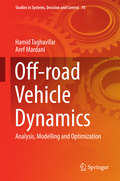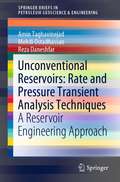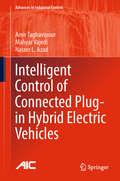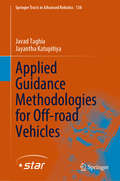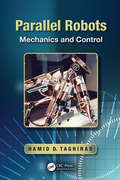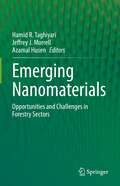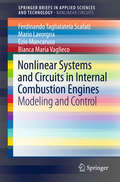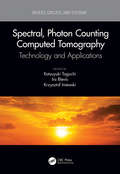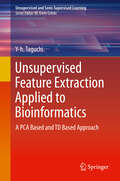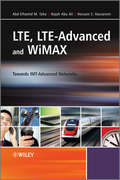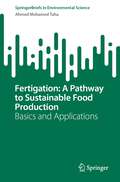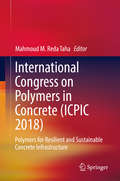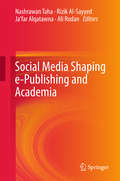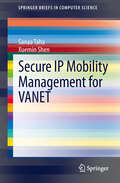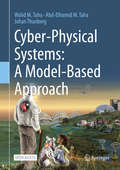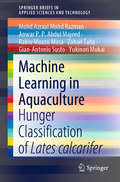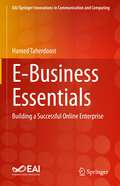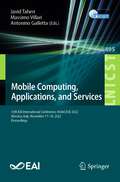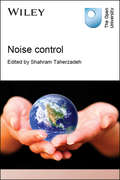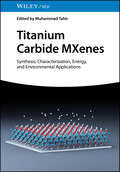- Table View
- List View
Off-road Vehicle Dynamics: Analysis, Modelling and Optimization (Studies in Systems, Decision and Control #70)
by Hamid Taghavifar Aref MardaniThis book deals with the analysis of off-road vehicle dynamics from kinetics and kinematics perspectives and the performance of vehicle traversing over rough and irregular terrain. The authors consider the wheel performance, soil-tire interactions and their interface, tractive performance of the vehicle, ride comfort, stability over maneuvering, transient and steady state conditions of the vehicle traversing, modeling the aforementioned aspects and optimization from energetic and vehicle mobility perspectives. This book brings novel figures for the transient dynamics and original wheel terrain dynamics at on-the-go condition.
Unconventional Reservoirs: A Reservoir Engineering Approach (SpringerBriefs in Petroleum Geoscience & Engineering)
by Amin Taghavinejad Mehdi Ostadhassan Reza DaneshfarThis book provides a succinct overview on the application of rate and pressure transient analysis in unconventional petroleum reservoirs. It begins by introducing unconventional reservoirs, including production challenges, and continues to explore the potential benefits of rate and pressure analysis methods. Rate transient analysis (RTA) and pressure transient analysis (PTA) are techniques for evaluating petroleum reservoir properties such as permeability, original hydrocarbon in-place, and hydrocarbon recovery using dynamic data. The brief introduces, describes and classifies both techniques, focusing on the application to shale and tight reservoirs. Authors have used illustrations, schematic views, and mathematical formulations and code programs to clearly explain application of RTA and PTA in complex petroleum systems. This brief is of an interest to academics, reservoir engineers and graduate students.
Intelligent Control of Connected Plug-in Hybrid Electric Vehicles (Advances in Industrial Control)
by Amir Taghavipour Mahyar Vajedi Nasser L. AzadIntelligent Control of Connected Plug-in Hybrid Electric Vehicles presents the development of real-time intelligent control systems for plug-in hybrid electric vehicles, which involves control-oriented modelling, controller design, and performance evaluation. The controllers outlined in the book take advantage of advances in vehicle communications technologies, such as global positioning systems, intelligent transportation systems, geographic information systems, and other on-board sensors, in order to provide look-ahead trip data. The book contains simple and efficient models and fast optimization algorithms for the devised controllers to address the challenge of real-time implementation in the design of complex control systems. Using the look-ahead trip information, the authors of the book propose intelligent optimal model-based control systems to minimize the total energy cost, for both grid-derived electricity and fuel. The multilayer intelligent control system proposed consists of trip planning, an ecological cruise controller, and a route-based energy management system. An algorithm that is designed to take advantage of previewed trip information to optimize battery depletion profiles is presented in the book. Different control strategies are compared and ways in which connecting vehicles via vehicle-to-vehicle communication can improve system performance are detailed. Intelligent Control of Connected Plug-in Hybrid Electric Vehicles is a useful source of information for postgraduate students and researchers in academic institutions participating in automotive research activities. Engineers and designers working in research and development for automotive companies will also find this book of interest.Advances in Industrial Control reports and encourages the transfer of technology in control engineering. The rapid development of control technology has an impact on all areas of the control discipline. The series offers an opportunity for researchers to present an extended exposition of new work in all aspects of industrial control.
Applied Guidance Methodologies for Off-road Vehicles (Springer Tracts in Advanced Robotics #138)
by Javad Taghia Jayantha KatupitiyaThis book provides methodologies for designing and implementing guidance algorithms for autonomous vehicles. These algorithms make important decision regarding how to steer and drive a ground vehicle in order to safely stay on an intended path, thereby making the vehicle driverless. The design tools provided in this book enable the reader to develop highly practical and real-world implementable guidance algorithms that will deliver high-accuracy driving for field vehicles. (They are equally applicable for on-road vehicles.) The book covers a variety of vehicle types, including wheeled vehicles, tracked vehicles, wheeled and tracked vehicles towing trailers, and four-wheel-steer and four-wheel-drive vehicles. It also covers active trailers that are driven and steered. Vehicles used in agriculture, mining and road construction are subjected to unpredictable and significant disturbances. The robust control methodologies presented can successfully compensate for these disturbances, as confirmed by the experimental results presented. Though the majority of the methodologies presented are based on sliding-mode controllers, other robust control methodologies are also discussed. To help the reader decide which controller is best suited for his/her choice of vehicle, experimental results are presented in a comparative format.
Parallel Robots: Mechanics and Control
by Hamid D. TaghiradParallel structures are more effective than serial ones for industrial automation applications that require high precision and stiffness, or a high load capacity relative to robot weight. Although many industrial applications have adopted parallel structures for their design, few textbooks introduce the analysis of such robots in terms of dynamics
Parallel Robots: Mechanics and Control
by Hamid D. TaghiradParallel structures are more effective than serial ones for industrial automation applications that require high precision and stiffness, or a high load capacity relative to robot weight. Although many industrial applications have adopted parallel structures for their design, few textbooks introduce the analysis of such robots in terms of dynamics
Emerging Nanomaterials: Opportunities and Challenges in Forestry Sectors
by Hamid R. Taghiyari Jeffrey J. Morrell Azamal HusenBio-based materials, including those containing wood, will become increasingly important as we move to a bio-based economy. Among their many attributes, it is vitally important that these materials are renewable, sustainable with proper management and environmentally benign. Wood remains one of our most important bio-based materials. While it is an amazing material, wood still has negative attributes and drawbacks that can affect performance, including dimensional instability when wetted, vulnerability to fire and high temperatures, and susceptibility to biodeterioration. A variety of treatments have been developed to overcome these weaknesses. Among the most exciting of these treatments are nanomaterials. These materials have some exceptionally attractive properties for improving timber performance and have been the subject of intensive research over the past decade. There is a tremendous need for a single comprehensive source of information on this rapidly emerging subject with tremendous potential to enhance the performance of a variety of bio-based materials. This book contains 10 chapters, each compiled by different author(s) who are considered the top researcher(s) in their respective fields. The chapters begin with some basic background on nanomaterials and their synthesis, then explore different areas for potential applications and conclude with a review of the emerging questions about nanomaterial safety. The book is designed to provide the latest information and know-how on application and utilization of different nanomaterials to improve the properties of wood and wood-based composite panels. The contents cover some main topics in the industry including improving physical and mechanical properties, increasing resistance to biodegradation (including fungi and insects), developing wood-plastic composites (WPC), applying nanomaterials in paper and board industry, and emergence of transparent wood and radiation shielding. It also covers the use of nanomaterials to improve the performance of paints and finishes used for forest products. The book provides a single location for those interested in the field to begin.
Nonlinear Systems and Circuits in Internal Combustion Engines: Modeling and Control (SpringerBriefs in Applied Sciences and Technology)
by Ferdinando Taglialatela-Scafati Mario Lavorgna Ezio Mancaruso Bianca Maria VagliecoThis brief provides an overview on the most relevant nonlinear phenomena in internal combustion engines with a particular emphasis on the use of nonlinear circuits in their modelling and control. The brief contains advanced methodologies —based on neural networks and soft-computing approaches among others— for the compensation of engine nonlinearities by using the combustion pressure signal and proposes several techniques for the reconstruction of this signal on the basis of different engine parameters, including engine-block vibration and crankshaft rotational speed. Another topic of the book is the diagnosis of the nonlinearities of injection systems and their balancing, which is a mandatory task for the new generation of gasoline direct injection engines. The authors come from both industrial and academic backgrounds, so the brief represents an important tool both for researchers and practitioners in the automotive industry.
Spectral, Photon Counting Computed Tomography: Technology and Applications (Devices, Circuits, and Systems)
by Katsuyuki Taguchi Ira Blevis Krzysztof IniewskiSpectral, Photon Counting Computed Tomography is a comprehensive cover of the latest developments in the most prevalent imaging modality (x-ray computed tomography (CT)) in its latest incarnation: Spectral, Dual-Energy, and Photon Counting CT. Disadvantages of the conventional single-energy technique used by CT technology are that different materials cannot be distinguished and that the noise is larger. To address these problems, a novel spectral CT concept has been proposed. Spectral Dual-Energy CT (DE-CT) acquires two sets of spectral data, and Spectral Photon Counting CT (PC-CT) detects energy of x-ray photons to reveal additional material information of objects by using novel energy-sensitive, photon-counting detectors. The K-edge imaging may be a gateway for functional or molecular CT. The book covers detectors and electronics, image reconstruction methods, image quality assessments, a simulation tool, nanoparticle contrast agents, and clinical applications for spectral CT.
Spectral, Photon Counting Computed Tomography: Technology and Applications (Devices, Circuits, and Systems)
by Katsuyuki Taguchi Ira Blevis Krzysztof IniewskiSpectral, Photon Counting Computed Tomography is a comprehensive cover of the latest developments in the most prevalent imaging modality (x-ray computed tomography (CT)) in its latest incarnation: Spectral, Dual-Energy, and Photon Counting CT. Disadvantages of the conventional single-energy technique used by CT technology are that different materials cannot be distinguished and that the noise is larger. To address these problems, a novel spectral CT concept has been proposed. Spectral Dual-Energy CT (DE-CT) acquires two sets of spectral data, and Spectral Photon Counting CT (PC-CT) detects energy of x-ray photons to reveal additional material information of objects by using novel energy-sensitive, photon-counting detectors. The K-edge imaging may be a gateway for functional or molecular CT. The book covers detectors and electronics, image reconstruction methods, image quality assessments, a simulation tool, nanoparticle contrast agents, and clinical applications for spectral CT.
Unsupervised Feature Extraction Applied to Bioinformatics: A PCA Based and TD Based Approach (Unsupervised and Semi-Supervised Learning)
by Y-h. TaguchiThis book proposes applications of tensor decomposition to unsupervised feature extraction and feature selection. The author posits that although supervised methods including deep learning have become popular, unsupervised methods have their own advantages. He argues that this is the case because unsupervised methods are easy to learn since tensor decomposition is a conventional linear methodology. This book starts from very basic linear algebra and reaches the cutting edge methodologies applied to difficult situations when there are many features (variables) while only small number of samples are available. The author includes advanced descriptions about tensor decomposition including Tucker decomposition using high order singular value decomposition as well as higher order orthogonal iteration, and train tenor decomposition. The author concludes by showing unsupervised methods and their application to a wide range of topics. Allows readers to analyze data sets with small samples and many features;Provides a fast algorithm, based upon linear algebra, to analyze big data;Includes several applications to multi-view data analyses, with a focus on bioinformatics.
LTE, LTE-Advanced and WiMAX: Towards IMT-Advanced Networks
by Abd-Elhamid M. Taha Najah Abu Ali Hossam S. HassaneinA concise introduction to IMT-Advanced Systems, including LTE-Advanced and WiMAX There exists a strong demand for fully extending emerging Internet services, including collaborative applications and social networking, to the mobile and wireless domain. Delivering such services can be possible only through realizing broadband in the wireless. Two candidate technologies are currently competing in fulfilling the requirements for wireless broadband networks, WiMAX and LTE. At the moment, LTE and its future evolution LTE-Advanced are already gaining ground in terms of vendor and operator support. Whilst both technologies share certain attributes (utilizing Orthogonal Frequency Division Multiple Access (OFDMA) in downlink, accommodating smart antennas and full support for IP-switching, for example), they differ in others (including uplink technology, scheduling, frame structure and mobility support). Beyond technological merits, factors such as deployment readiness, ecosystem maturity and migration feasibility come to light when comparing the aptitude of the two technologies. LTE, LTE-Advanced and WiMAX: Towards IMT-Advanced Networks provides a concise, no-nonsense introduction to the two technologies, covering both interface and networking considerations. More critically, the book gives a multi-faceted comparison, carefully analyzing and distinguishing the characteristics of each technology and spanning both technical and economic merits. A “big picture” understanding of the market strategies and forecasts is also offered. Discusses and critically evaluates LTE, LTE-Advanced and WiMAX (Legacy and Advanced) Gives an overview of the principles and advances of each enabling technology Offers a feature-by-feature comparison between the candidate technologies Includes information which appeals to both industry practitioners and academics Provides an up-to-date report on market and industry status
LTE, LTE-Advanced and WiMAX: Towards IMT-Advanced Networks
by Abd-Elhamid M. Taha Najah Abu Ali Hossam S. HassaneinA concise introduction to IMT-Advanced Systems, including LTE-Advanced and WiMAX There exists a strong demand for fully extending emerging Internet services, including collaborative applications and social networking, to the mobile and wireless domain. Delivering such services can be possible only through realizing broadband in the wireless. Two candidate technologies are currently competing in fulfilling the requirements for wireless broadband networks, WiMAX and LTE. At the moment, LTE and its future evolution LTE-Advanced are already gaining ground in terms of vendor and operator support. Whilst both technologies share certain attributes (utilizing Orthogonal Frequency Division Multiple Access (OFDMA) in downlink, accommodating smart antennas and full support for IP-switching, for example), they differ in others (including uplink technology, scheduling, frame structure and mobility support). Beyond technological merits, factors such as deployment readiness, ecosystem maturity and migration feasibility come to light when comparing the aptitude of the two technologies. LTE, LTE-Advanced and WiMAX: Towards IMT-Advanced Networks provides a concise, no-nonsense introduction to the two technologies, covering both interface and networking considerations. More critically, the book gives a multi-faceted comparison, carefully analyzing and distinguishing the characteristics of each technology and spanning both technical and economic merits. A “big picture” understanding of the market strategies and forecasts is also offered. Discusses and critically evaluates LTE, LTE-Advanced and WiMAX (Legacy and Advanced) Gives an overview of the principles and advances of each enabling technology Offers a feature-by-feature comparison between the candidate technologies Includes information which appeals to both industry practitioners and academics Provides an up-to-date report on market and industry status
Fertigation: Basics and Applications (SpringerBriefs in Environmental Science)
by Ahmed Mohamed TahaThis book introduces basic and practical information on fertigation to researchers, extension agents and growers. To provide understanding of the basic issues regarding the appropriate selection of fertilizer injectors, fertilizer compounds used in fertigation for growing various field and horticultural crops. The book provides useful basic principles and practical information concerning fertilizer management and fertigation techniques of field, horticulture, and medicinal and aromatic crops. The book focuses on the agronomic value of fertigation practice and provides the reader with best practical advice required for successful fertigation based on the field experience. This book summarizes the basic principles and practices of fertigation techniques to ensure accurate and efficient crop nutrition. The book consists of 5 chapters covering the following topics: Introduction to chemigation and fertigation, selecting an injector for fertilizer/chemical injection, fertilizers for fertigation, major, secondary, and micronutrient fertilizers used in fertigation, and fertigation practices: Egyptian case study. It also includes appendixes for fertigation calculation examples, calibration of an injection pump, calculating the quantities of fertilizers needed for fertigation, nutrients requirements per each ton of crop yield produced, macronutrient requirements for some filed, fiber, fruit, vegetable crops, and medicinal and aromatic plants.Fertigation is one of the smart practices that help attains sustainable food production and minimize environmental pollution. Fertigation is the application of dissolved mineral fertilizers, soil amendments, and other water-soluble products to the roots of crops through irrigation water. This book provides understanding of the basic issues regarding the appropriate selection of injectors and fertilizer compounds used in fertigation for growing various field and horticultural crops which are essential to attain higher productivity, increasing food security and reducing food contaminations. It also clarifies the advantages of fertigation and set solutions to overcome its disadvantages.
International Congress on Polymers in Concrete: Polymers for Resilient and Sustainable Concrete Infrastructure (ICPIC #2018)
by Mahmoud M. TahaThis volume collects the proceedings from the International Congress of Polymers in Concrete 2018 (ICPIC), held under the theme “Polymers for Resilient and Sustainable Concrete Infrastructure.” ICPIC 2018 provides an opportunity for researchers and specialists working in the fields of polymers to exchange ideas and follow the latest progress in the use of polymers in concrete infrastructure. It also showcases the use of polymers and polymer concrete in sustainable and resilient development, and provides a platform for local and overseas suppliers, developers, manufacturers and contractors using polymers, polymer concrete and polymer composites in concrete structures to develop new business opportunities and follow the latest developments in the field. The International Congress of Polymers in Concrete is an international forum that has taken place every three years for the last 40 years with the objective of following progress in the field of polymers and their use in concrete and construction. Following 15 successful congresses held in London (1975), Austin (1978), Koriyama (1981), Darmstadt (1984), Brighton (1987), Shanghai (1990), Moscow (1992), Oostende (1995), Bologna (1998), Honolulu (2001), Berlin (2004), Chuncheon (2007), Funchal (2010), Shanghai (2013) and Singapore (2015), the 16th ICPIC will take place in Washington, DC, from April 29 to May 1st, 2018.
Social Media Shaping e-Publishing and Academia
by Nashrawan Taha Rizik Al-Sayyed Ja'Far Alqatawna Ali RodanThis book presents the current state of the art in the field of e-publishing and social media, particularly in the Arabic context. The book discusses trends and challenges in the field of e-publishing, along with their implications for academic publishing, information services, e-learning and other areas where electronic publishing is essential. In particular, it addresses (1) Applications of Social Media in Libraries and Information Centers, (2) Use of Social Media and E-publishing in E-learning (3) Information Retrieval in Social Media, and (4) Information Security in Social Media.
Secure IP Mobility Management for VANET (SpringerBriefs in Computer Science)
by Sanaa Taha Xuemin ShenThis brief presents the challenges and solutions for VANETs’ security and privacy problems occurring in mobility management protocols including Mobile IPv6 (MIPv6), Proxy MIPv6 (PMIPv6), and Network Mobility (NEMO). The authors give an overview of the concept of the vehicular IP-address configurations as the prerequisite step to achieve mobility management for VANETs, and review the current security and privacy schemes applied in the three mobility management protocols. Throughout the brief, the authors propose new schemes and protocols to increase the security of IP addresses within VANETs including an anonymous and location privacy-preserving scheme for the MIPv6 protocol, a mutual authentication scheme that thwarts authentication attacks, and a fake point-cluster based scheme to prevent attackers from localizing users inside NEMO-based VANET hotspots. The brief concludes with future research directions. Professionals and researchers will find the analysis and new privacy schemes outlined in this brief a valuable addition to the literature on VANET management.
Cyber-Physical Systems: A Model-Based Approach
by Walid M. Taha Abd-Elhamid M. Taha Johan ThunbergIn this concise yet comprehensive Open Access textbook, future inventors are introduced to the key concepts of Cyber-Physical Systems (CPS). Using modeling as a way to develop deeper understanding of the computational and physical components of these systems, one can express new designs in a way that facilitates their simulation, visualization, and analysis. Concepts are introduced in a cross-disciplinary way. Leveraging hybrid (continuous/discrete) systems as a unifying framework and Acumen as a modeling environment, the book bridges the conceptual gap in modeling skills needed for physical systems on the one hand and computational systems on the other. In doing so, the book gives the reader the modeling and design skills they need to build smart, IT-enabled products. Starting with a look at various examples and characteristics of Cyber-Physical Systems, the book progresses to explain how the area brings together several previously distinct ones such as Embedded Systems, Control Theory, and Mechatronics. Featuring a simulation-based project that focuses on a robotics problem (how to design a robot that can play ping-pong) as a useful example of a CPS domain, Cyber-Physical Systems: A Model-Based Approach demonstrates the intimate coupling between cyber and physical components, and how designing robots reveals several non-trivial control problems, significant embedded and real-time computation requirements, and a need to consider issues of communication and preconceptions.
Machine Learning in Aquaculture: Hunger Classification of Lates calcarifer (SpringerBriefs in Applied Sciences and Technology)
by Zahari Taha Gian-Antonio Susto Yukinori Mukai Mohd Azraai Mohd Razman Anwar P. P. Abdul Majeed Rabiu Muazu MusaThis book highlights the fundamental association between aquaculture and engineering in classifying fish hunger behaviour by means of machine learning techniques. Understanding the underlying factors that affect fish growth is essential, since they have implications for higher productivity in fish farms. Computer vision and machine learning techniques make it possible to quantify the subjective perception of hunger behaviour and so allow food to be provided as necessary. The book analyses the conceptual framework of motion tracking, feeding schedule and prediction classifiers in order to classify the hunger state, and proposes a system comprising an automated feeder system, image-processing module, as well as machine learning classifiers. Furthermore, the system substitutes conventional, complex modelling techniques with a robust, artificial intelligence approach. The findings presented are of interest to researchers, fish farmers, and aquaculture technologist wanting to gain insights into the productivity of fish and fish behaviour.
E-Business Essentials: Building a Successful Online Enterprise (EAI/Springer Innovations in Communication and Computing)
by Hamed TaherdoostThis textbook presents comprehensive treatment of the e-business environment and the tools and strategies necessary for success in the digital realm. The author covers a wide range of e-business-related topics, such as e-environment, e-business security, billing and payment systems, supply chain management, digital marketing, customer relationship management, business intelligence, e-business adoption, change management, performance measurement, legal, and regulatory. The book focuses on the ethical and legal issues of e-business and offers practical advice for establishing and maintaining successful e-business operations. The book also discusses the challenges of keeping up with swiftly evolving technology and the ever-changing internet landscape, including online transactions, data security, and administration. The author seeks to advance e-business research and practice by providing a comprehensive and up-to-date overview of the field. The author includes case studies that span various industries and companies, from small startups to large corporations, providing readers with a diverse and practical perspective on e-business.
Mobile Computing, Applications, and Services: 13th EAI International Conference, MobiCASE 2022, Messina, Italy, November 17-18, 2022, Proceedings (Lecture Notes of the Institute for Computer Sciences, Social Informatics and Telecommunications Engineering #495)
by Javid Taheri Massimo Villari Antonino GallettaThis book constitutes the thoroughly refereed post-conference proceedings of the 13th International Conference on Mobile Computing, Applications, and Services, MobiCASE 2022, held in Messina, Italy, in November 17-18, 2022. The 9 full papers were carefully reviewed and selected from 25 submissions. The papers are organized in topical tracks: mobile computing; machine learning/deep learning; dependable systems; and emerging applications.
Noise Control
by Shahram TaherzadehDesigned to accompany the new Open University course in Environmental Monitoring and Protection, this is one of four new titles which will equip the reader with the tools to undertake Environmental Impact Assessments (EIAs). Used in planning, decision-making and management, EIAs review both the theoretical principles and environmental considerations of engineering and environmental projects to help steer fundamental legislation in the right direction. This book will cover the basic principles and concepts of sound and sound propagation, covering units, criteria and indices. It considers noise propagation and attenuation, before leading on to assessment methods for both industrial and transport noise. It includes models for predicting sound levels both indoors and outdoors, and details methods for noise control and abatement. Discover our e-book series on Environmental Monitoring and Protection, published in partnership with The Open University! Find out more about the series editors, the titles in the series and their focus on water, noise, air and waste, and The Open University courses in Environmental Management. Visit www.wiley.com/go/ouebookseries
Noise Control
by Shahram TaherzadehDesigned to accompany the new Open University course in Environmental Monitoring and Protection, this is one of four new titles which will equip the reader with the tools to undertake Environmental Impact Assessments (EIAs). Used in planning, decision-making and management, EIAs review both the theoretical principles and environmental considerations of engineering and environmental projects to help steer fundamental legislation in the right direction. This book will cover the basic principles and concepts of sound and sound propagation, covering units, criteria and indices. It considers noise propagation and attenuation, before leading on to assessment methods for both industrial and transport noise. It includes models for predicting sound levels both indoors and outdoors, and details methods for noise control and abatement. Discover our e-book series on Environmental Monitoring and Protection, published in partnership with The Open University! Find out more about the series editors, the titles in the series and their focus on water, noise, air and waste, and The Open University courses in Environmental Management. Visit www.wiley.com/go/ouebookseries
Titanium Carbide MXenes: Synthesis, Characterization, Energy and Environmental Applications
by Muhammad TahirTitanium Carbide MXenes Discover the future of solar energy with this introduction to an essential new family of materials MXenes are a recently-discovered family of two-dimensional organic compounds formed from transition metal carbides. Their unique properties, such as high stability and electron conductivity, have made them a sought-after commodity with many industrial applications in cutting-edge industries. In particular, titanium carbide MXenes look poised to have significant applications in the solar energy industry, with potentially revolutionary consequences for the sustainable energy future. Titanium Carbide MXenes offers a thorough and accessible introduction to this family of compounds and their possible applications. It begins by surveying the fundamentals of the MXene groups, before characterizing titanium carbide MXenes and their processes of synthesis. It then moves on to discuss applications, current and future. The result is a must-read for researchers and professionals looking to synthesize and construct these materials and apply them in sustainable industry. Titanium Carbide MXenes readers will also find: Detailed treatment of MXenes including nitrides composites, perovskites composites, and more Discusses applications in photocatalytic CO2 reduction, hydrogen production, water splitting, and more Roughly 100 figures illustrating key concepts Titanium Carbide MXenes is a must-have for materials scientists, catalytic chemists, and scientists in industry.
Titanium Carbide MXenes: Synthesis, Characterization, Energy and Environmental Applications
by Muhammad TahirTitanium Carbide MXenes Discover the future of solar energy with this introduction to an essential new family of materials MXenes are a recently-discovered family of two-dimensional organic compounds formed from transition metal carbides. Their unique properties, such as high stability and electron conductivity, have made them a sought-after commodity with many industrial applications in cutting-edge industries. In particular, titanium carbide MXenes look poised to have significant applications in the solar energy industry, with potentially revolutionary consequences for the sustainable energy future. Titanium Carbide MXenes offers a thorough and accessible introduction to this family of compounds and their possible applications. It begins by surveying the fundamentals of the MXene groups, before characterizing titanium carbide MXenes and their processes of synthesis. It then moves on to discuss applications, current and future. The result is a must-read for researchers and professionals looking to synthesize and construct these materials and apply them in sustainable industry. Titanium Carbide MXenes readers will also find: Detailed treatment of MXenes including nitrides composites, perovskites composites, and more Discusses applications in photocatalytic CO2 reduction, hydrogen production, water splitting, and more Roughly 100 figures illustrating key concepts Titanium Carbide MXenes is a must-have for materials scientists, catalytic chemists, and scientists in industry.
